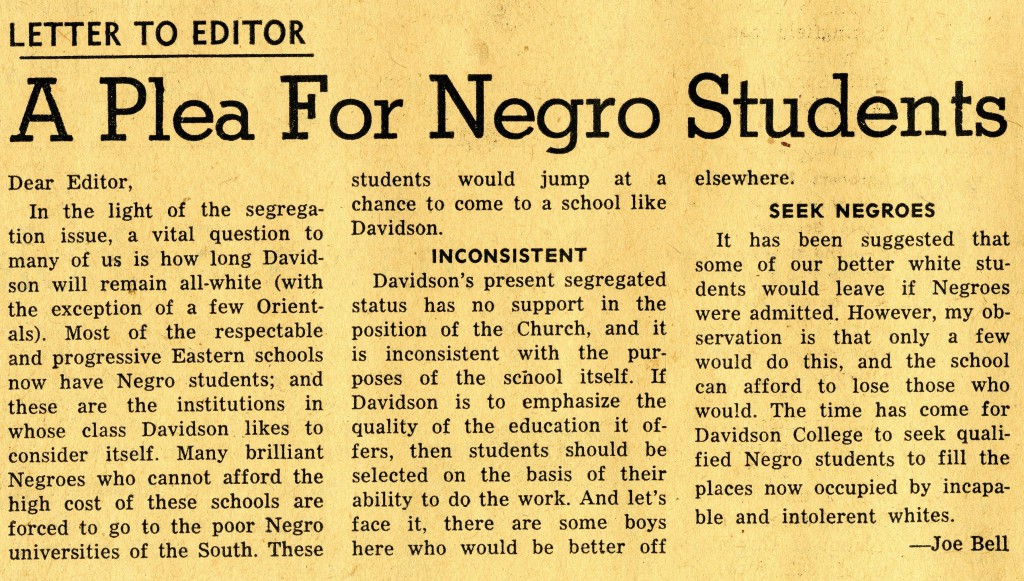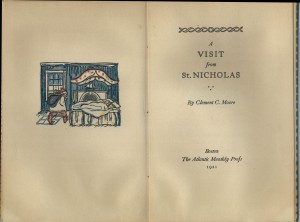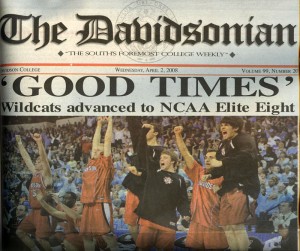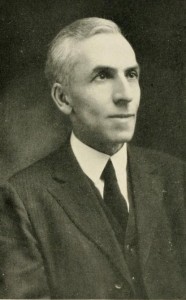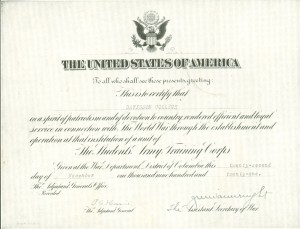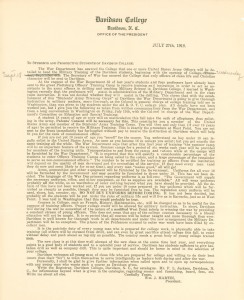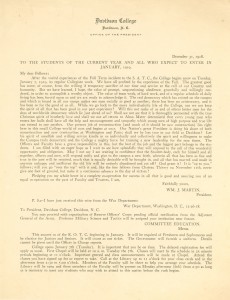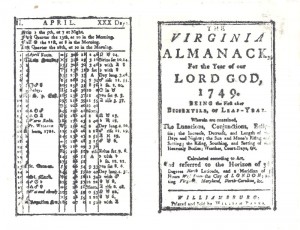In honor of Black History Month, this week’s blog focuses on the history of integration at Davidson College, from the mid-1950s up until the admission of the first black student in 1962. Next week’s blog will focus on the experiences of those early black students at Davidson, particularly through their own words and reflections. For a broader view of black history in Davidson, check out the short documentary Always Part of the Fabric and its accompanying text supplement.
The Brown vs. Board of Education rulings in 1954 paved the way towards desegregation in public schools, and while Davidson is a private institution, the dialogue created by Brown vs. Board of Education began local conversations on integration. The Charlotte-Mecklenburg County school system began the process of desegregation in 1957; as the school system’s history page notes, “At the time, Charlotte was very much a segregated city, with black schools and white schools within the district. The schools reflected the larger social context in a city with no integrated hotels, restaurants, restrooms, churches, cemeteries or theaters.”
As articles and editorials in The Davidsonian demonstrate, campus opinions on integration varied widely from the mid-1950s until 1962 and beyond. In March 1956, Professor Cecil Kenneth Brown (Class of 1921; math and economics faculty, 1923-1957) gave a pro-segregation talk on campus entitled “The Southern Position with Respect to the Bi-Racial System” (later printed in the July 28, 1956 issue of The State, now Our State magazine, as “The White South: A Minority Group”).
Two years later, student Joseph Bell (Class of 1960) wrote a letter to the editor in support of admitting black students, printed in the January 17, 1958 issue of The Davidsonian. Bell noted that “Davidson’s present segregated status has no support in the position of the Church, and it is inconsistent with the purposes of the school itself.”
In April 1958, the first known admissions inquiry was made on behalf of a potential black student. Frank E. Parker wrote a letter to Frederick W. Hengeveld (Class of 1918, Registrar and Director of Admissions, 1946-1967), requesting information on the college for his son. Parker wrote:
“We are Negroes – and ‘thereby hangs a tale.’ Our motives for seeking admission to your institution are not predicated upon any intent to establish a precedent, nor agitate the prevailing race patterns. We seek the quality training available from your school.”
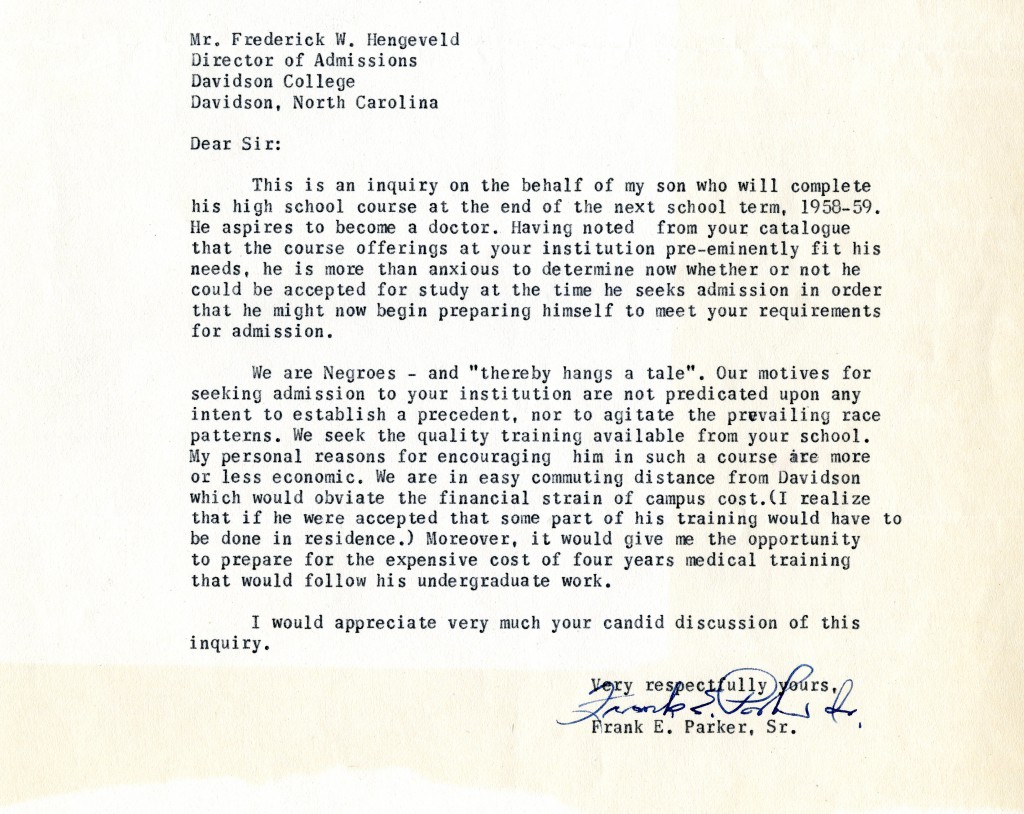
Frank Parker, Sr.’s letter to Director of Admissions Frederick Hengeveld, from which the title of this post is taken.
Admissions Director Hengeveld directed the Parkers’ request and following application (in November 1958) to the Board of Trustees for a decision. The Board formed a special committee to “study the question of admitting black applicants” (Davidsonian article, February 17, 1998) but did not release a decision. Hengeveld responded to Frank Parker, Jr. on November 26, 1958:
“Since the Trustees have not taken any action which would authorize the admission of Negro students, and since we do not know when they will or whether they will take such action, we feel it is wise to advise you to make application to other institutions so that you may be sure of acceptance elsewhere.”
At their meeting on February 18, 1959 the Board of Trustees passed “The Majority Report of the Admission of Negroes to Davidson College,” based on the findings of the special committee. However, this statement was not released to the public until October 1959. An attachment to the report notes that the recommendation was modified to read:
“In the view of the request of the Education Committee with reference to the matter of the admission of Negroes, the college authorities responsible for admitting students be advised that it is the judgment of a majority of the Trustees that at this time the admission of Negroes is not in the best interest of the College, of the Church, of the Students, or of any Negroes who at this juncture would be admitted as students.”
In the meantime, The Davidsonian ran another editorial calling for a decision on the matter of integration. The March 6, 1959 article stated: “We think the time has come to end such ostrich-headed attitudes. Why not consider the possibility? Why not honestly try to find out what effects there might be if a qualified Negro student enrolled at the college?”
On October 6, 1959, then College President David Grier Martin (Class of 1932, College President 1958-1968) addressed the faculty and student body and announced the Board of Trustees decision:
“The Trustees decided that it was not in the best interest of the college to admit a Negro student at this time. Since this was not a change in the ‘unwritten’ policy which Davidson has been following, the majority of the Trustees felt it would not be necessary to make a public announcement.”
Two months later, segregationist and newspaper editor Thomas R. Waring gave an address to the student body of Davidson while at chapel. That week’s Davidsonian ran an interview with Waring in which he was asked: “What is your opinion concerning the integration of an institution such as Davidson College?” Waring responded: “I’d say this: you have a pretty good college now, why change it? You’d run the risk of losing North and South Carolina boys whose families oppose this thing, and contributors from Southern states would surely fall away.”
Waring also served on a panel at Davidson with Charles Jones of Johnson C. Smith University, a historically black university in Charlotte. The Davidsonian reported that Jones countered Waring’s comments by “point[ing] out that many things are denied the Negro which are a vital part of the Southern way of life – education, social rights, and other opportunities.”
That same week, faculty member William Gatewood Workman (psychology professor, 1951-1977) moved for the faculty to conduct a vote on a statement of whether they supported integration, and whether to integrate now or in the future. The results of the faculty vote would be submitted to the Board of Trustees.
For the Board of Trustees meeting in February 1960, The Davidsonian created a special issue focused on the meeting and the issue of admitting black students. This issue included the results of poll conducted by Davidsonian staff, several letters to the editor, and a cartoon lampooning the values of the Presbyterian Church as practiced in a policy of segregation.

The February 16, 1960 “Trustee Special” issue of The Davidsonian ran the results of the student poll, with an editor’s note stating that there were “numerous reports of ballot stuffing” and that the staff had hesitated to print the results.
At the Feburary 1960 Trustees meeting, Henry Shue (Class of 1961) presented a petition signed by over 250 Davidson students, requesting that the Trustees reopen discussion on integration and further study the matter. Shue had also set up meetings with willing Trustees to discuss the students’ opinions on integration.
A year later, nine Davidson alumni serving as missionaries at the American Presbyterian Congo Mission sent a letter to President Martin, urging that the college consider admitting African students in order to train these students to become Presbyterian leaders in their own countries. This request aligned with the General Assembly of the Presbyterian Church, U.S.’s 1954 and 1960 proceedings, urging Presbyterian affiliated institutions to look into desegregation.
The Trustees discussed this request from the alumni missionaries in their February 1961 meeting, and made the decision to admit up to three Congolese students for the following year. The February 17, 1961 Davidsonian reported that when then Board of Trustees President J. McDowell Richards (Class of 1922) was asked whether “this action was ‘not inconsistent with the policy laid two two years ago’ when the board voted that ‘it is not in the best interests of Davidson College to integrate at this time,'” Richards responded, ‘”Perhaps it is an inconsistency…But the board felt it necessary to to back the Board of World Missions on this matter.”
That same issue also featured an article by student Tom Parker (Class of 1961), criticizing The Davidsonian‘s coverage of integration at the college:
“Two years ago the Davidson student body, assembled in chapel, applauded the statement ‘It is not in the interest of Davidson College to admit Negroes at this time.’ Last year, through a clearly worded petition, they expressed their desire that Davidson remain a segregated institution at least for the present time. Despite these setbacks, those on this campus who favor integration have renewed their efforts… it is interesting to consider the devices which they employ to gain their objectives, especially those which are used in an openly sympathetic newspaper (which nonetheless declares itself in its letterhead to be “The News and Editorial Voice of Davidson College.”)
Local criticism of the decision to integrate, an indication of the difficulties the potential international students from Africa would face once enrolled at Davidson, appeared in the March 3, 1961 Davidsonian:
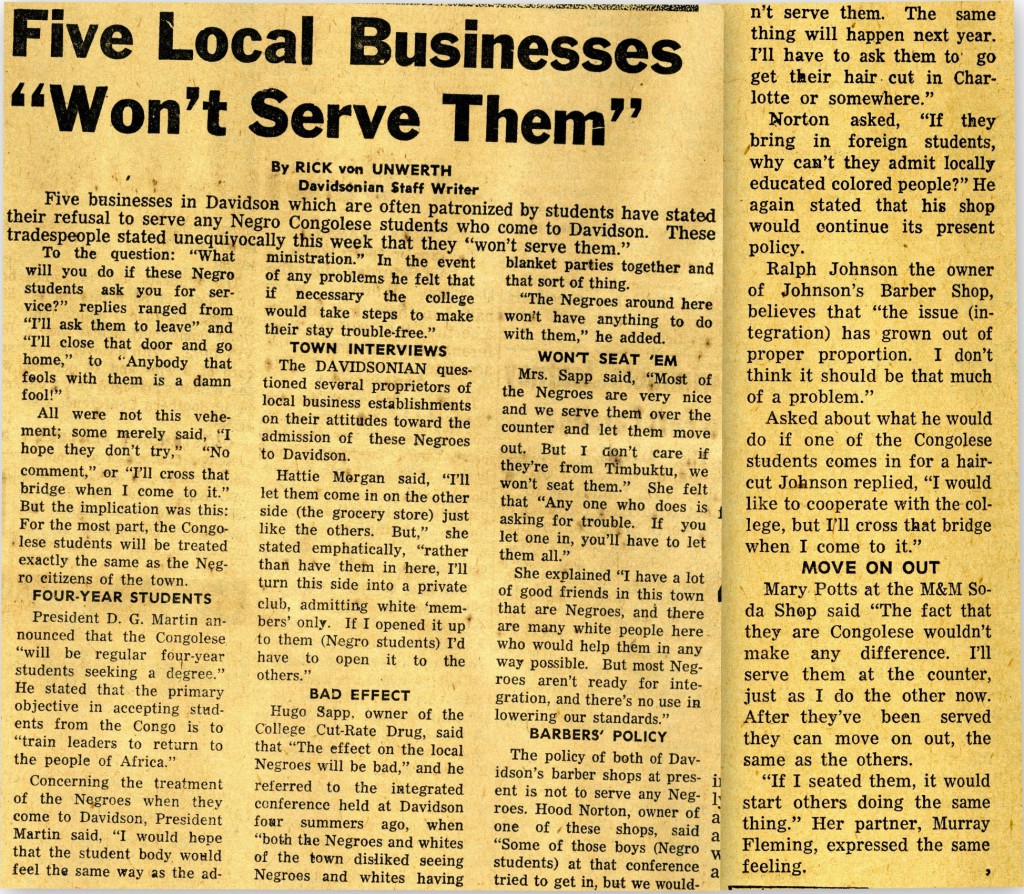
An article in the March 3, 1961 Davidsonian, reporting on local businesses’ reactions to the possibility of African students attending Davidson and frequenting their establishments: “Five Local Businesses ‘Won’t Serve Them’.”
After the Trustees decision, President Martin established a committee “dealing with Congolese students” and appointed faculty member Dan Rhodes (Class of 1938, religion professor 1960-1984) to chair it. The committee, comprised of faculty, students, and community members, was tasked with investigating potential issues Congolese students would face.

Letter from committee chair Dan Rhodes to the members of the committee detailing each sub-committee’s assignments.
Though the Trustees had voted to admit a limited number of Congolese students, no black students enrolled at Davidson for the 1961-1962 academic year. From the May 5, 1961 Davidsonian story, “Martin: ‘We Will Have No Congolese Next Fall'”:
‘”The Board of World Missions in Nashville tells me that our missionary group has assigned ten students – none to Davidson – for good reasons… The Board of World Missions will plan to send one to us when they have one they consider qualified.’ Davidson’s Congolese Committee will continue meeting in preparation for the future, Martin said.”
Students and faculty continued to probe the issue throughout the next academic year, with the faculty voting in January 1962 to urge “the Trustees of the College authorize the admission of qualified students of any race and nationality.” The final tally of the faculty vote was 53 in favor and 14 against (1 abstention). Though the Trustees had voted to allow a limited number of students from the Congo, this decision still barred American black students from enrolling at Davidson.
The Davidsonian conducted another student opinion poll on integration, with then student body president, George Trask (Class of 1962), sending the results of the student poll to College President Martin for distribution to the Board of Trustees.

Trask’s letter to President Martin, showing that 59% of the student body had responded to the poll, with 53% in favor of “the admission of qualified students of any race of nationality to Davidson College.”
Armed with the faculty vote and a student opinion poll, both showing a campus majority favored integration, President Martin took the question of officially integrating the college, rather than allowing a small, capped number of students specifically from one African country to the Board of Trustees. On May 17, 1962, at their meeting the Trustees of Davidson College approved a resolution to open “the college to students regardless of race or nationality.” (The Davidsonian, May 18, 1962)

Front page of the May 18, 1962 Davidsonian, announcing that “Congolese students may enter in Sept.” The top headline for that issue read, “Trustees Abolish Segregation Policy; Martin Reveals $835,000 Bequest.”
On the decision to integrate with international black students, rather than American students, professor Dan Rhodes recalled in an April 20, 1991 Charlotte Observer article by Pam Kelley, “Challenge of integration remains: Davidson’s first black student attends 25th class reunion”: “Africans were seen as less threatening. They were foreigners, so they were more acceptable, in a sense.”
In fall 1962, the first black student enrolled at Davidson College – Benoit Nzengu, from the Congo. Next week’s blog will cover Ben Nzengu’s and the other early black students’ experiences at Davidson from 1962-1977 – watch this space!
